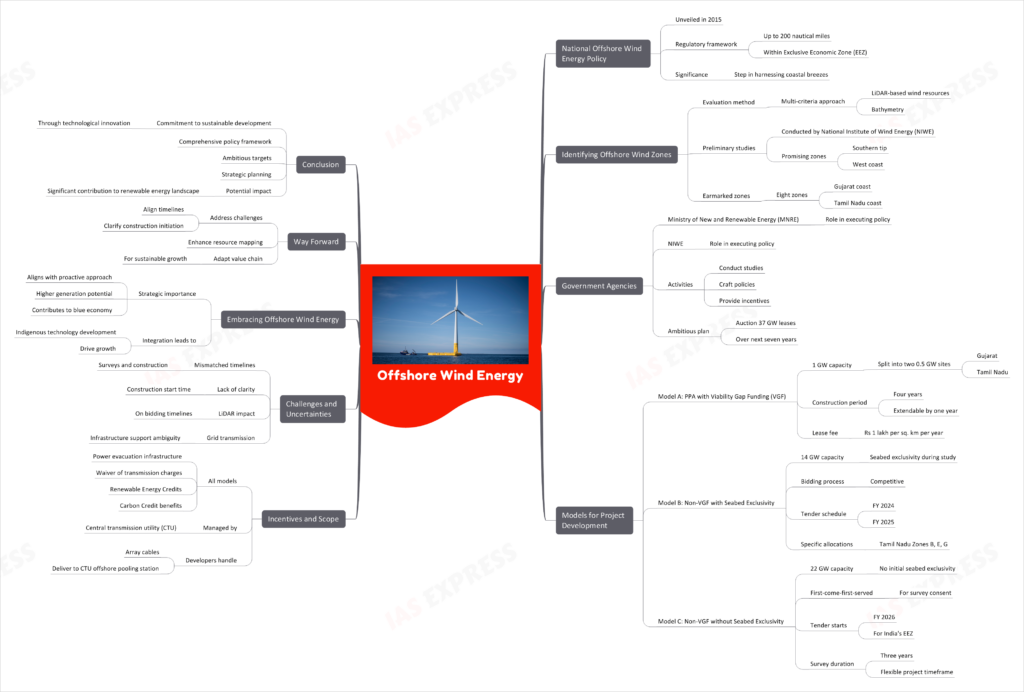Offshore Wind Energy- How is India Planning to Harness Coastal Breeze?

India’s pursuit of offshore wind energy has gained momentum with the unveiling of the National Offshore Wind Energy Policy in 2015. The policy establishes a regulatory framework for offshore wind energy expansion up to 200 nautical miles from the coastline, within the Exclusive Economic Zone (EEZ). This comprehensive policy marks a significant step forward in India’s journey towards harnessing coastal breezes.

This topic of “Offshore Wind Energy- How is India Planning to Harness Coastal Breeze?” is important from the perspective of the UPSC IAS Examination, which falls under General Studies Portion.
Identifying Offshore Wind Zones
India’s offshore wind potential has been meticulously evaluated using a multi-criteria approach, considering factors like LiDAR-based wind resources and bathymetry. Preliminary studies conducted by the National Institute of Wind Energy (NIWE) have identified promising zones for development, particularly the southern tip and west coast. Eight zones off the coasts of Gujarat and Tamil Nadu have been earmarked as potential offshore wind energy zones.
Government Agencies Driving Progress
The Ministry of New and Renewable Energy (MNRE) and NIWE are pivotal in executing the National Offshore Wind Energy Policy. These agencies conduct thorough studies, craft policies, and provide incentives to stimulate private sector investments in offshore wind projects. India’s ambitious plan includes auctioning 37 GW of offshore site leases over the next seven years, demonstrating the government’s commitment to sustainable energy.
Models for Project Development
India’s offshore wind development strategy encompasses three distinct models:
Model A: Power Purchase Agreement (PPA) with Viability Gap Funding (VGF)
- Involves a 1 GW capacity split into two 0.5 GW sites in Gujarat and Tamil Nadu.
- Four-year construction period, extendable by a year.
- Developers pay a floor lease fee of Rs 1 lakh per sq. km per year.
Model B: Non-VGF with Seabed Exclusivity
- Encompasses a 14 GW capacity with seabed exclusivity during study/survey.
- Competitive bidding for site lease allocation.
- Scheduled tenders in FY 2024 and FY 2025.
- Specific allocation details for Tamil Nadu Zones B, E, and G.
Model C: Non-VGF without Seabed Exclusivity
- Envisions a 22 GW capacity without initial seabed exclusivity.
- First-come-first-served basis for survey consent.
- Tendering commences from FY 2026 for India’s EEZ.
- Survey duration of three years, flexible project development timeframe.
Incentives and Scope
All models provide various incentives, including power evacuation infrastructure, waiver of transmission charges, Renewable Energy Credits, Carbon Credit benefits, subject to government decisions. The central transmission utility (CTU) manages key components, while developers handle array cables and deliver them to the CTU offshore pooling station.
Challenges and Uncertainties
The revised offshore wind strategy faces several challenges:
- Mismatched timelines for surveys and construction across models.
- Lack of clarity on when construction duration starts.
- Uncertain impact of LiDAR installation on bidding timelines.
- Ambiguity regarding grid transmission infrastructure support.
Embracing Offshore Wind Energy: A Strategic Move
India’s proactive approach to embracing new technologies for energy needs is evident. Offshore wind energy aligns with this ethos, offering higher generation potential and contributing to the blue economy. This integration can lead to the development of indigenous technology and drive growth.
Way Forward
As India navigates its offshore wind journey, addressing challenges and uncertainties will be crucial. Ensuring alignment in timelines, clarity on construction initiation, and enhancing resource mapping can streamline progress. Learning from initial efforts and adapting the value chain will be essential for sustainable growth.
Conclusion
India’s foray into offshore wind energy reflects its commitment to sustainable development through technological innovation. With a comprehensive policy framework, ambitious targets, and strategic planning, India is poised to harness the power of coastal breezes, contributing significantly to its renewable energy landscape.
Practice Question for Mains
Discuss India’s offshore wind energy policy and its implications for the country’s renewable energy landscape. (250 words)

